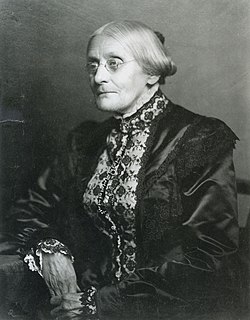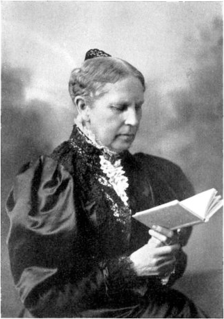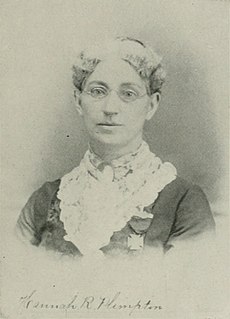Jane Amy McKinney (October 25, 1832 - 1905) was an American educator and philanthropist. She was actively engaged in temperance work and in the advocacy of women's suffrage.
Jane Amy McKinney (October 25, 1832 - 1905) was an American educator and philanthropist. She was actively engaged in temperance work and in the advocacy of women's suffrage.
Jane Amy was born in Vermont, on October 25, 1832. From both father and mother, she inherited marked characteristics. They were devoutly religious and possessed a robust humanitarianism, which bore fruit while they lived and left its impress on their daughters. The mother's family was devoted to literature and scientific investigation. One of her brothers was the first man to construct a galvanic battery to control electricity, before Morse took up the invention. For years the effort of his inventive genius was unknown, at the end of the 19th century it was chronicled in electrical literature. [1]
The family moved to northern Ohio in 1835, and settled in Mentor, Ohio. [1]
Amy was educated in the Western Reserve Seminary and in Oberlin College, Ohio. [1] [2]
Since the age of fifteen Jane Amy McKinney was engaged in educational and philanthropic work almost continuously. In Iowa she was actively engaged in temperance work and in the advocacy of woman suffrage. She served a term of four years by election of the legislature as trustee of the hospital for the insane in Independence, Iowa. She was president of the Cook County Equal Suffrage Association. [1] Susan B. Anthony helped McKinney to organize the Winnesheik County Woman Suffrage Association in 1875. McKinney was a skilled legislative lobbyist. [2]
She did kindergarten work and was supervisor of the Chicago Kindergarten Training School. [1]
Jane Amy married James P. McKinney (1827-1903) in 1856 and went with her husband to Decorah, Iowa, where her home was until 1888 when she moved to Chicago, Illinois. They had one daughter, Mabel McKinney Smith (1867-1968). [1]
She died in 1905 and is buried at Phelps Cemetery, Decorah, Iowa.

Susan B. Anthony was an American social reformer and women's rights activist who played a pivotal role in the women's suffrage movement. Born into a Quaker family committed to social equality, she collected anti-slavery petitions at the age of 17. In 1856, she became the New York state agent for the American Anti-Slavery Society.

Elizabeth Cady Stanton was an American writer and activist who was a leader of the women's rights movement in the U.S. during the mid- to late-19th century. She was the main force behind the 1848 Seneca Falls Convention, the first convention to be called for the sole purpose of discussing women's rights, and was the primary author of its Declaration of Sentiments. Her demand for women's right to vote generated a controversy at the convention but quickly became a central tenet of the women's movement. She was also active in other social reform activities, especially abolitionism.
The Woman's Christian Temperance Union (WCTU) is an international temperance organization. It was among the first organizations of women devoted to social reform with a program that "linked the religious and the secular through concerted and far-reaching reform strategies based on applied Christianity." It plays an influential role in the temperance movement. The organization supported the 18th Amendment and was also influential in social reform issues that came to prominence in the progressive era.

Frances Elizabeth Caroline Willard was an American educator, temperance reformer, and women's suffragist. Willard became the national president of Woman's Christian Temperance Union (WCTU) in 1879 and remained president until her death in 1898. Her influence continued in the next decades, as the Eighteenth and Nineteenth Amendments to the United States Constitution were adopted. Willard developed the slogan "Do Everything" for the WCTU and encouraged members to engage in a broad array of social reforms by lobbying, petitioning, preaching, publishing, and education. During her lifetime, Willard succeeded in raising the age of consent in many states as well as passing labor reforms including the eight-hour work day. Her vision also encompassed prison reform, scientific temperance instruction, Christian socialism, and the global expansion of women's rights.

Mary Livermore was an American journalist, abolitionist, and advocate of women's rights. Her printed volumes included: Thirty Years Too Late, first published in 1847 as a prize temperance tale, and republished in 1878; Pen Pictures; or, Sketches from Domestic Life; What Shall We Do with Our Daughters? Superfluous Women, and Other Lectures; and My Story of the War. A Woman's Narrative of Four Years' Personal Experience as Nurse in the Union Army, and in Relief Work at Home, in Hospitals, Camps and at the Front during the War of the Rebellion. For Women of the Day, she wrote the sketch of the sculptress, Miss Anne Whitney; and for the Centennial Celebration of the First Settlement of the Northwestern States, at Marietta, Ohio, July 15, 1788, she delivered the historical address.

Amelia Jenks Bloomer was an American newspaper editor, women's rights and temperance advocate. Even though she did not create the women's clothing reform style known as bloomers, her name became associated with it because of her early and strong advocacy. In her work with The Lily, she became the first woman to own, operate and edit a newspaper for women.
Hannah Maria Conant Tracy Cutler was an American abolitionist as well as a leader of the temperance and women's suffrage movements in the United States. Cutler served as president of the Ohio Woman Suffrage Association and the American Woman Suffrage Association (AWSA). Cutler helped to shape the merger of two feminist factions into the combined National American Woman Suffrage Association (NAWSA).

Phoebe Wilson Couzins was one of the first female lawyers in the United States. She was the second woman to serve as a licensed attorney in Missouri and the third or fourth to be a licensed attorney in the United States. She was the first woman admitted to the Missouri and Utah bars, and was also admitted to the Kansas and Dakota Territory bars. She was the first female appointed to the U.S. Marshal service. After her career in law she played an active part in the Suffrage movement.

Mary Stafford Anthony was an American suffragist during the women's rights movement of the 19th century. Anthony was employed as a school teacher in Western New York, and was eventually promoted to the position of principal within the Rochester City School District, where she was the first woman known to receive equal pay with men in the same job.

Naomi Bowman Talbert Anderson was an African American suffragist, temperance leader, civil rights activist, and writer who advocated for equal rights for all genders and races in the 1870s. She wrote poetry and gave speeches highlighting the experience of African American women who were still enslaved by their inability to vote, receiving considerable praise from other suffragists for her contributions to the movement.

Olive Pond Amies was an American educator, lecturer, and editor from the U.S. state of New York. She founded the training school for teachers in Lewiston, Maine; served as editor of a Universalist Church publication; and was the first president of the Woman's Health Protective Association of the United States. Amies favored the temperance movement and women's suffrage.

Hannah Rebecca Cope Plimpton was a Woman's Relief Corps worker.
Amanda M. Way was a pioneer in the temperance and women's equal rights movements, an American Civil War nurse, a minister in the Methodist Episcopal Church in the 1870s, and a Society of Friends (Quaker) minister by the mid-1880s. Way, a founding member of the Indiana Woman's Rights Association, called for the state's first women's rights convention in 1851 and served as vice president of the proceedings. Way remained active in the Association, including service as its president in 1855, and helped reactivate it in 1869, renamed as the Indiana Woman's Suffrage Association. Elizabeth Cady Stanton and Susan B. Anthony dubbed her the "mother of 'The Woman Suffrage Association' in Indiana" for her early leadership and efforts in initiating the first women's rights convention in the state.

Laura M. Johns was an American suffragist and journalist. She served as president of the Kansas State Suffrage Association six times, and her great work was the arrangement of thirty conventions beginning in Kansas City in February, 1892. She also served as president of the Kansas Republican Woman's Association, superintendent of the Kansas Woman's Christian Temperance Union, and field organizer of the National American Woman Suffrage Association (NAWSA). Johns died in 1935.

Marietta Bones was an American woman suffragist, social reformer, and philanthropist. In 1881 Bones was elected vice-president of the National Woman Suffrage Association (NWSA) and annually re-elected for nine years. In 1890 suffragist Susan B. Anthony and supporters of the movement merged the National Women Suffrage Association into the National American Women Suffrage Association (NAWSA). In 1882, Bones made her first appearance as a public speaker in Webster, soon to be Webster, South Dakota, where she later resided. She was an active temperance worker, and was secretary of the first Non-Partisan National Woman's Christian Temperance Union (WCTU) in 1889. She took great interest in all reform and charitable institutions.

Martha Waldron Janes was an American minister, social reformer, and columnist. Born in Michigan, she was converted when very young. Her religious zeal was so conspicuous that many questioned her sanity. She preached for some time from the pulpits of the Free Baptist Church, before becoming regularly ordained in 1868, being the first woman ordained in that conference. The denomination espoused more egalitarian views than others of the time, which matched well with Janes' convictions regarding social reform. She opposed prescriptive gender beliefs regarding limitations on educational opportunities for girls. At a young age, she embraced women's suffrage and wrote columns on the topic for seventeen weekly papers. She was also actively engaged in temperance work. Janes died in 1913.

Elizabeth Greer Coit was a prominent Ohio suffragist and humanitarian, who founded Columbus' first women's suffrage organization and was its inaugural President.

Sarah Maria Clinton Perkins was an American Universalist minister, social reformer, lecturer, editor, and author of Sunday school books. Early in life she was engaged in educational work. She was involved in the temperance movement and advocated for women's suffrage. She was an early abolitionist, an early Prohibitionist. Perkins was a highly educated woman, a writer and speaker of rare force. Moving to Cleveland, Ohio, after being widowed in 1880, she was for many years actively connected as National Lecturer with the Woman's Christian Temperance Union (WCTU). She filled various other positions in reform associations including, President of Cleveland's Equal Franchise Club, and president of the Literary Guild of Cleveland.